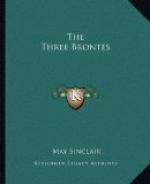That is Lucy. But when Polly reappears fitfully as Pauline de Bassompierre, she is an ordinary, fastidious little lady without a spark of imagination or of passion.
Now in the first three chapters of Villette, Charlotte Bronte concentrated all her strength and all her art on the portrait of little Polly. The portrait of little Polly is drawn with the most delicate care and tender comprehension, and the most vivid and entire reality. I cannot agree with Mr. Swinburne that George Eliot, with her Totty and Eppie and Lillo, showed a closer observation of the ways, or a more perfect understanding of the heart of a child. Only little Maggie Tulliver can stand beside little Polly in Villette. She is an answer to every critic, from Mr. Swinburne downwards, who maintains that Charlotte Bronte could not draw children.
But Lucy at fourteen is drawn with slight and grudging strokes, sufficient for the minor part she is evidently to play. Lucy at Bretton is a mere foil to little Polly. Charlotte Bronte distinctly stated in her letters that she did not care for Miss Snowe. “Lucy must not marry Dr. John; he is far too youthful, handsome, bright-spirited, and sweet-tempered; he is a ‘curled darling’ of Nature and of fortune, and must draw a prize in life’s lottery. His wife must be young, rich, pretty; he must be made very happy indeed. If Lucy marries anybody, it must be the Professor—a man in whom there is much to forgive, much to ‘put up with’. But I am not leniently disposed towards Miss Frost: from the beginning I never meant to appoint her lines in pleasant places.” “As to the character of Lucy Snowe, my intention from the first was that she should not occupy the pedestal to which Jane Eyre was raised by some injudicious admirers. She is where I meant her to be, and where no charge of self-laudation can touch her.”
But Lucy is not altogether where she was meant to be. When she reappears at the Pensionnat it is with “flame in her soul and lightning in her eyes”. She reminds M. Paul “of a young she wild creature, new caught, untamed, viewing with a mixture of fire and fear the first entrance of the breaker-in”.
“‘You look,’ said he, ’like one who would snatch at a draught of sweet poison, and spurn wholesome bitters with disgust.’”




